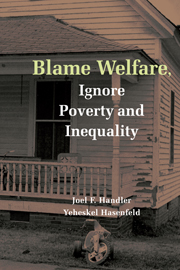Book contents
- Frontmatter
- Contents
- Acknowledgments
- List of Acronyms
- 1 Introduction
- 2 The State of Poverty: TANF Recipients
- 3 The Response to Poverty and Inequality: The Welfare State
- 4 Demonizing the Single-Mother Family: The Path to Welfare Reform
- 5 The Welfare Bureaucracy
- 6 Work and the Low-Wage Labor Market: Mothers and Children
- 7 Welfare Reform and Moral Entrepreneurship: Promoting Marriage and Responsible Parenthood and Preventing Teenage Pregnancy
- 8 Addressing Poverty and Inequality
- References
- Author Index
- Subject Index
8 - Addressing Poverty and Inequality
Published online by Cambridge University Press: 20 August 2009
- Frontmatter
- Contents
- Acknowledgments
- List of Acronyms
- 1 Introduction
- 2 The State of Poverty: TANF Recipients
- 3 The Response to Poverty and Inequality: The Welfare State
- 4 Demonizing the Single-Mother Family: The Path to Welfare Reform
- 5 The Welfare Bureaucracy
- 6 Work and the Low-Wage Labor Market: Mothers and Children
- 7 Welfare Reform and Moral Entrepreneurship: Promoting Marriage and Responsible Parenthood and Preventing Teenage Pregnancy
- 8 Addressing Poverty and Inequality
- References
- Author Index
- Subject Index
Summary
The Starting Point
This book is primarily about single mothers and their children. Other categories of people are poor and are clearly in need of help – two-adult families, childless couples, nonaged single adults, and children without families. A principal theme of this book is how this country has substituted “welfare” for poverty and inequality, how we have demonized the single-mother family, and why the more pressing issues are poverty and inequality. There is no moral or logical reason why other categories of the poor should not be included, and, as is discussed shortly, most of our proposals would apply to other categories of the poor. But in one book (already too long) we cannot cover everyone.
Even within the category of poor single-mother families, we cannot explore all the relevant issues. We concentrate on income support (basically, a children's allowance), reforming the low-wage labor market, improving child care, and community-based employment/services for those who have barriers to the labor market. Other relevant issues such as health care, affordable housing, education, transportation, and neighborhoods are clearly important to improving the lives of these families. We touch on these issues, but, again, we only mention the importance of these issues and discuss some of the parameters, but cannot deal with them in detail.
There has to be adequate income support for these families. By adequate support, we mean a minimum adequate standard budget, which is discussed at length in Chapter 2. A minimum adequate budget is not the official poverty line.
[…]
- Type
- Chapter
- Information
- Blame Welfare, Ignore Poverty and Inequality , pp. 316 - 348Publisher: Cambridge University PressPrint publication year: 2006

